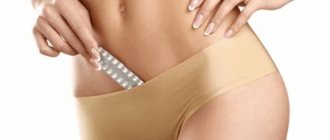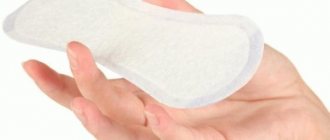In newborns
Discharge in newborn girls appears at approximately 2–3 weeks of life. They do not have an unpleasant aroma and do not irritate the delicate skin of the baby. Sometimes there may be streaks of blood, which is also normal.
This is caused by too high levels of hormones that the child received from the mother while still in the womb. And a few weeks after birth, their level decreases sharply, which causes the onset of a sexual crisis, which is accompanied not only by the appearance of discharge, but also by an enlargement of the mammary glands.
The sexual crisis lasts for a long time - 7 - 8 years. But in newborns it makes itself felt only in the first year of life. And if there are no signs of inflammation or infection (the newborn’s labia do not swell, do not peel, do not turn red, etc.), then the mother should not worry and run with her baby to the hospital to get tested.
Important! If a little girl’s pussy discharges profuse leucorrhoea of a constant nature and is accompanied by unpleasant symptoms, immediately go to the doctor. Since if the mother has infectious diseases, they can easily be transmitted to the child during childbirth when passing through the birth canal.
7 – 8 years
Girls aged 7–8 years also experience white vaginal discharge. And this is due to the onset of puberty, during which the active process of puberty occurs.
Pathological vaginal discharge
The appearance of white discharge in girls is not always the norm.
In children from one to 7 years of age, leucorrhoea is most often considered a sign of hormonal disorders and/or an inflammatory process in the vagina (vulvitis and vulvovaginitis).
It must be remembered that at this age the absence of any vaginal discharge is considered normal.
The main causes of pathological vaginal discharge are:
- long-term use of antibacterial drugs associated with vaginal dysbiosis or the addition of fungal microflora (thrush);
- recent respiratory diseases;
- childhood infections are often complicated by vulvovaginitis;
- allergic diathesis;
- helminthic infestation (enterobiasis);
- metabolic disorders in obesity, diabetes;
- urogenital infections in the mother with infection during childbirth or through household contact (ureaplasmosis, mycoplasma, chlamydia);
- violations of intimate hygiene due to infection with dirty hands, use of wet wipes after bowel movement, and improper washing technique.
Parents need to know that girls of preschool age are more susceptible to developing infectious diseases of the genital organs. This is due to the lack of lactic acid bacteria, which maintain an optimal balance between opportunistic and positive vaginal microflora.
Signs of pathological vaginal discharge
Symptoms of “bad” discharge include:
- the appearance of signs of an inflammatory process - itching, redness of the vulva and pathological discharge from the vagina (the nature of the discharge depends on the cause of the disease);
- discharge with an unpleasant odor and streaks of blood;
- copious foamy discharge and redness of the genital tract due to Trichomonas infection;
- curdled discharge with itching due to fungal vulvovaginitis;
- light discharge, which is accompanied by severe redness with severe itching, may indicate a helminthic infestation;
- the appearance of blisters and ulcers on the external genitalia with pain and light leucorrhoea is characteristic of a herpetic infection;
- Bacterial vaginosis is characterized by the appearance of milky or grayish liquid discharge with the smell of rotten fish.
To clarify the presence of pathological vaginal discharge, it is necessary to urgently contact a pediatric gynecologist and conduct an examination.
pediatrician Sazonova Olga Ivanovna
Save
Save
Article read: 2,741
What is not the norm?
Speaking about why girls have discharge on their panties, it is also necessary to talk about the pathologies that are accompanied by this symptom. Since their appearance can negatively affect the state of the girl’s reproductive system in the future.
17 years
At this age, there is no vaginal discharge of any kind, including leucorrhoea in girls, since during this age period the ovaries produce too few hormones. Their appearance is considered a direct sign of hormonal imbalance or the development of inflammation in the vagina.
Age characteristics
Estrogen synthesis in the fetal ovaries is low, but maternal estrogens easily cross the placenta and help in the development of the newborn's mucous membranes. From birth to eight weeks of life, the girl is under the influence of maternal estrogens. The labia are significantly thickened and cover the vaginal opening. Estrogen levels begin to fall after the newborn period, reaching a minimum between the ages of three and eight years. Due to low estrogen levels, the reproductive tissues become atrophic. The labia majora appears as a thin strip of normal skin surrounding the vaginal opening. The labia minora are thin, almost absent, and the vaginal opening lies in close proximity to the anus. The initially thick hymen becomes thin and translucent. The vaginal epithelium, slightly reddened, may appear inflamed. After age nine, estrogen levels begin to rise, signaling the onset of puberty. Under the influence of estrogen, the external genitalia begin to take the shape of adult genitalia.
Prevention
Buying medications on your own, as well as using traditional medicine methods to treat discharge in girls, is extremely dangerous. But no one is stopping mothers from adhering to certain rules that reduce the risk of pathological secretion:
- Carry out hygiene procedures in the morning and before bed.
- Use only the child's clean, individual towel.
- It is better to give preference to warm boiled water.
- Choose safe intimate hygiene products that do not cause allergies.
- Teach your daughter to properly wash her genitals to avoid infection from the intestines.
- Prevent mechanical damage to the vagina that is caused by washcloths and sponges.
- Buy underwear made from natural fabrics, avoid synthetics.
How and with what to treat the discharge will be determined only by a specialist after examining the child and receiving test results. The information presented on the Internet should be used extremely carefully and solely for informational purposes, because any specialist on the Internet, even Komarovsky, cannot verbally assess the child’s condition and select treatment based on the description.
«>
I have had leucorrhoea for 3 years now and have not gotten my period, should I see a doctor?
The fact that you have had leucorrhoea for 3 years, but your period has not come, is normal, I say again that these are not interrelated concepts and leucorrhoea and menstruation can be on their own.
When should you consult a doctor? If you notice a change in the nature of your leucorrhoea, that is, they were always of one type, but at other times they became another, especially if they became:
- yellow
- pink
- torn
- brown
- started to smell very bad
- they became very cheesy
- too creamy
In general, something that is unusual for your body, not typical, does not smell very pleasant and has a rather strange consistency, in this case you should definitely consult a doctor. And of course, you need to contact a gynecologist, there are pediatric gynecologists, there are gynecologists for older adults, that is, no matter how old you are, you can still contact a gynecologist if something bothers you. That is, if you suddenly have too much discharge, any question you have, it’s normal to contact a gynecologist just for a consultation, they’ll take a test, and maybe you’re fine, or maybe you have some kind of inflammation.
Diagnosis of the disease
To determine the diagnosis, the girl is examined and a smear is taken for analysis (the analysis is necessary to determine the causative agent of the infection). In some cases, a pelvic ultrasound is prescribed. After making sure that the symptoms are caused by Candida albicans fungi, the doctor prescribes treatment.
Attention! Mothers should pay attention to the health of their teenage girls. And at the slightest suspicion of thrush, take your child to a pediatric gynecologist. However, an examination by a specialist should not come as a surprise. First, talk about the need to visit a doctor and possible complications, convince the girl of the importance of treatment.
Prevention of candidiasis
With an adequate approach, it is not difficult to cure thrush. But not everyone can avoid re-infection. To prevent your child from becoming a “victim” of relapse, take preventive measures:
- Limit your intake of carbohydrate and fatty foods.
- Make sure that the girl follows the rules of hygiene (intimate and not only).
- Do not allow the use of intimate gels with fragrances and toxic colors (explain why products with neutral Ph are better).
- Get used to changing underwear daily (panties made from natural fabrics).
- Cure diseases in a timely manner, preventing them from becoming chronic.
- Talk about the dangers of early sexual activity and the consequences of sexually transmitted infections.
- Don't let yourself sit at the computer all the time (pay for a swimming pool, yoga, fitness or dancing classes).
- Explain how to choose and use sanitary pads correctly.
If your daughter does not get enough sleep, although she goes to bed as usual, if she sits in the bathroom for a long time and changes her panties several times a day, take her to a pediatric gynecologist. Most likely, the child is embarrassed to talk about an intimate problem and does not even imagine what consequences such secrecy could lead to.
Do not stuff the girl with antifungal pills, because during puberty the body suffers from hormonal surges, and it is impossible to predict its reaction to a particular drug. So it’s better to leave self-medication and entrust the child’s health to a qualified specialist.
Treatment of purulent discharge in girls
If there is active bacterial overgrowth, antibiotics should be prescribed. Oral penicillins, cephalosporins or erythromycin are used. However, most episodes do not have a specific cause. In these cases, treatment should focus on improving hygiene, hand washing and sitz baths. Girls should sit in warm water with added antiseptics for 10-15 minutes once or twice a day. Liquid soap can be used, but the vulva should not be washed aggressively or vigorously. After this, you need to carefully blot the vulva area or allow it to air dry. Clothes should be washed in a mild detergent without additives or regular detergents.
Small amounts of ointment such as Vaseline or lanolin can be used to protect the skin of the vulva.
Alena Paretskaya, pediatrician, medical columnist
3, total, today
( 50 votes, average: 4.66 out of 5)
Gynecological massage: indications, how it is done
Medical abortion: indications, contraindications, timing
Related Posts
Treatment
Pathological discharge in a 5-year-old girl, as well as a similar problem at another age, always require adequate treatment. Therapeutic measures are carried out strictly on an individual basis, taking into account the characteristics of the child’s body and the type of pathogen identified.
General recommendations
Increased attention is paid to how general principles of child care are followed. This is important not only in terms of prevention, but also allows you to get the best effect from treatment and prevent the progression of the disease. Mom should consider the following recommendations:
- Monitor the hygiene and cleanliness of the child’s genitals.
- When washing, do not overdo it with soap and other products.
- Monitor your diet (if breastfeeding) and follow a diet for a girl (exclude possible allergens).
- Change underwear and bed linen frequently.
- Treat infectious diseases in a timely manner.
- Sanitate chronic foci of infection.
In addition, you should try to avoid contact with sick people, and try to lead as healthy a lifestyle as possible.
Normalization of lifestyle and hygienic conditions is of great importance not only for prevention, but also has a positive effect on the outcome of treatment.
Medicines
Discharge in girls aged four years, just like in older children, should be treated with medication. Therapy should be aimed at destroying the causative agent of the infection, normalizing the vaginal and intestinal microflora, increasing the local and general immune defense of the body. For this purpose, various drugs are used:
- Antibiotics.
- Antifungal.
- Antihelminthic.
- Probiotics.
- Immunocorrectors.
- Vitamins.
- Antioxidants.
The prescription of antimicrobial agents is justified only after receiving the result of a microbial sensitivity test. Local treatment with antiseptic solutions (rinsing), ointments (applications), and herbal decoctions (baths) are widely used. Only the doctor will tell you which specific drug to use, and the woman must follow all his recommendations. In combination with preventive measures, this will be decisive in eliminating the discharge and completely curing the child.
Publication date: Allocations










